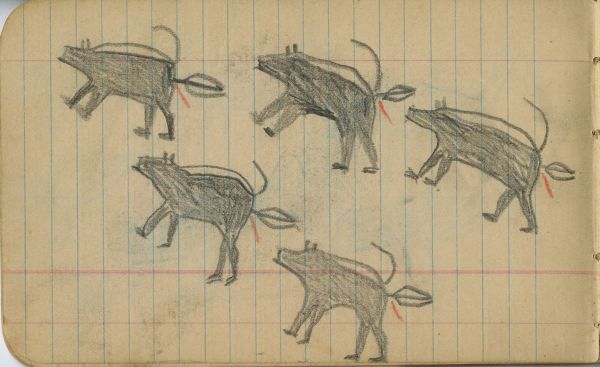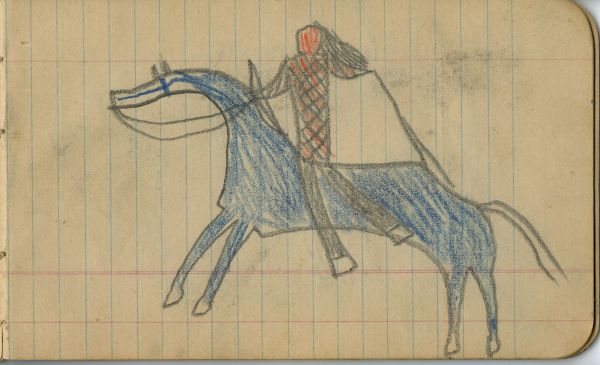HUNTING: Man on Blue Horse with Bow Shooting 5 Skunks with Arrows
Ethnographic Notes
See Plate 5 for discussion of skunks in terms of supernatural and war-related powers. This diptych is unnatural because of the five skunks grouped together, as skunks are solitary animals. p. 24 HUNTING SCENE: Five Striped Skunks. One, two, and two skunks fill the page. The face right to left, in profile. White stripes down their backs are distinctive, and their tails are arched up. However, they are not attacking, as attacking skunks will curve their bodies in a C shape to face enemies and also have their scent glands pointed at the target. These animals move the left, as the hunter chases them. Their ears are pricked upward. Arrow shafts protrude from their rears. The arrows may penetrate from the opposite side, just not visible, or they may indeed penetrate the anus or scent glands. The fletches are clearly outlined. A line of red appears at the point of impact, to indicate a fatal wound. Media: Lead pencil outlines, fill, and details; red crayon p. 25 HUNTING SCENE: Man on Blue Horse with Bow and Quirt The man pursuing the five skunks wears his hair loose and without ornament. His face in painted entirely red. His shirt is striped red and black (lead pencil), probably gingham cloth. His left, outstretched hand holds a quirt, which touches the horse's back. Use of a quirt indicates the man is urging the horse forward. The man's right hand holds a bow, just visible, and the horse's reins. He wears long Cheyenne-style breech cloth, made of trade cloth with undyed selvedge ends, and both ends show. The man's legs do not show. The blue roan horse is outlined in lead pencil and filled with blue crayon coloring. The hooves are left uncolored. The horse's tail is two lines of lead pencil detail, and the horse's ears are detailed. The reins are simple, attached to the horse�s jaw. Blue horses appear often in ledger art, including the 1879 Dodge City ledger notebooks. Castle McLaughlin and Butch Thunder Hawk curated an exhibit at Harvard University's Peabody Museum based on a ledger book that included blue roan horses. They wrote this about the blue horses depicted in that ledger: "Lakotas favored blue roans as war horses, as their color indicated the strength and speed of the sky powers." Some of the 1879 Dodge City men who created these drawings were of Lakota descent, close allies of Lakotas or had Lakota wives. Contemporary Nokota horses descend from these horses: "The Nokota horses of North Dakota are descended in part from animals that Sitting Bull and other Lakotas surrendered to the U.S. military at Fort Buford in 1880. Although blue roan is a rare color, it is still dominant among Nokota horses� (McLaughlin and Thunder Hawk). This 2013 exhibit "Wiyohpiyata: Lakota Images of the contested West" centers around an 1860s Lakota ledger captured by the U.S. Army after the defeat of Custer at Greasy Grass. The ledger is the "Half Moon" ledger book, MS Am2337, Houghton Library, Harvard University, gift of Harriet J. Bradbury, 1930. Media: Lead pencil outlines, fill, and details; red and blue crayon


